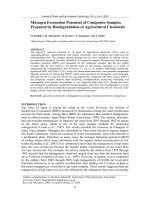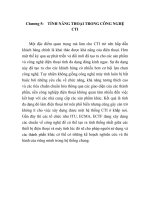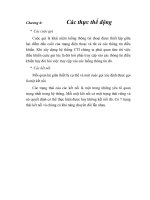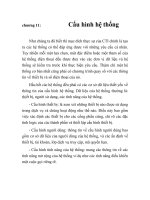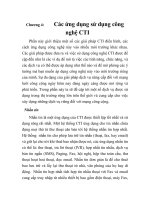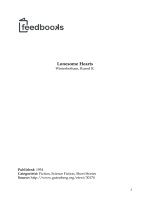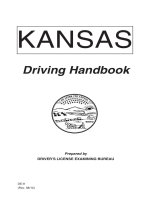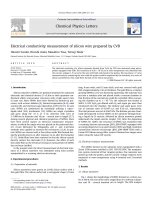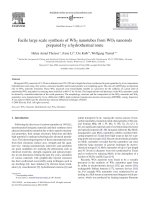Industrial Chemistry: Prepared by Helen Njeri NJENGA ppt
Bạn đang xem bản rút gọn của tài liệu. Xem và tải ngay bản đầy đủ của tài liệu tại đây (1.99 MB, 168 trang )
Prepared by Helen Njeri NJENGA
African Virtual university
Université Virtuelle Africaine
Universidade Virtual Africana
Industrial
Chemistry
African Virtual University 1
Notice
This document is published under the conditions of the Creative Commons
Attribution
License (abbreviated “cc-by”), Version 2.5.
African Virtual University 2
I. Industrial Chemistry ________________________________________ 3
II. Prerequisite Course or Knowledge _____________________________
3
III. Time ____________________________________________________ 3
IV. Materials _________________________________________________4
V. Module Rationale __________________________________________
4
VI. Content __________________________________________________ 5
6.1 Overview ___________________________________________
5
6.2 Outline _____________________________________________5
6.3 Graphic Organizer _____________________________________
7
VII. General Objective(s) ________________________________________
8
VIII. Specific Learning Activities ___________________________________
8
IX. Pre-assessment __________________________________________11
X. Compiled List of all Key Concepts (Glossary) ____________________
14
XI. Compiled List of Compulsory Readings ________________________
15
XII. Compiled List of Resources _________________________________
16
XIII. Compiled List of Useful Links ________________________________
17
XIV. Learning Activities _________________________________________
20
XV. Synthesis of the Module ___________________________________
162
XVI. Summative Evaluation ____________________________________
163
XVII. References _____________________________________________
165
XVIII. Student records _________________________________________
166
XIX. Main Author of the Module _________________________________
166
XX. File Structure _____________________________________________
167
African Virtual University 3
By Dr. Helen Njeri Njenga, University of Nairobi and William Wanasolo
Module 5
Unit I Basic Organic Chemistry
Unit II Hydrocarbons
Unit III Alkyl halides
Unit IV Amines
Module 6
Unit I Alcohols and ethers
Unit III Carboxylic acids and their derivatives
Module 7
Unit I Benzene and its derivatives
Unit III Heterocyclic compounds
Module 9
Thermodynamics
Chemical principles of variable constituents
This unit will require 120 hours
• Unit I Introduction to industrial chemistry and the chemical industry (15 hrs)
• Unit 2. Unit Operations and Unit Processes (20 hrs)
• Unit 3. Industrial Inorganic Chemistry I (Extractive Metallurgy) (10 hrs)
• Unit 4. Industrial Inorganic Chemistry II (Chlor-alkali, Ammonia, Sulphuric
Acid, Fertilizer and Cement) (20 hrs)
• Unit 5. Industrial Organic Chemistry I (Petroleum, Petrochemicals and Po-
lymers) (25 hrs)
• Unit 6. Industrial Organic Chemistry II (Fermentation, Ethanol, Pharmaceu-
ticals, Soaps and Detergents) (25 hrs)
African Virtual University 4
You will require the following tools and resources for completing the module:
Computer, CD-ROM, and e-library
• To access this module, exams and other relevant material
• To access other suggested reference materials
• For interactive discussions/chat sessions
Recommended textbooks and reference materials
• To assist learning and further understanding of topics in the module
Industrial chemistry deals with commercial production of chemicals and related
products from natural raw materials and their derivatives. It enables humanity to
experience the benets of chemistry when we apply it in the exploitation of materials
and energy. When we apply chemistry in the transformation of materials and energy
to make useable products, this results in growth and improvement in areas such as
food production, health and hygiene, shelter and clothing. The economic growth of
industrialized countries relies on the manufacturing industry for nished products. The
goal of studying industrial chemistry at university is to try and bridge the gap between
classical chemistry and chemistry is applied in industry. The chemical industry is
highly globalized and produces thousands of chemicals from a wide variety of raw
materials by means of varied technologies for varied end uses. It is therefore important
to base the study of industrial chemistry on an understanding of the structure of the
industry and the unit operations and unit processes that make up the chemical pro-
cesses. On the basis of natural raw materials sources and the chemistry involved, we
nd it easier to study industrial inorganic and industrial organic chemistry separately,
Through the electrolysis of brine, we obtain chlorine and sodium hydroxide both of
which are important reactants in organic synthesis of products such as petrochemicals
and detergents respectively. By xing nitrogen, we obtain ammonia, from which
we can make fertilizers. From sulphur, we get sulphuric acid, which we use, in the
manufacture of phosphate fertilizers. Mineral ores as well as being raw materials for
basic chemicals are the source of pure metals, which we use elsewhere in building
and construction, manufacture of equipment, machines and jewellery. Turning now
to organic chemical industry, we use petroleum as the source of petrochemicals and
synthetic polymers. Fermentation enables us to convert natural organic materials into
chemicals, some like penicillin being pharmaceutical ingredients. From natural oils
and fats, we obtain soaps and detergents.
African Virtual University 5
6.1 Overview
This module starts by dening industrial chemistry and then gives a view of the
chemical industry, its position in the general economy, and its classication in terms
of the chemical processes that characterize it. To enable the study of selected chemi-
cal processes, unit operations and unit processes, especially those that are relevant
in later learning actvities, are then covered in Unit 2. With this background, it will
be easy to study industrial inorganic and organic chemical industries. The study of
extractive metallurgy in Unit 3 draws on the knowledge of size reduction and sepa-
ration unit operations learnt earlier, as well as chemical conversions that take place
during pyroprocessing. The extractive metallugy of iron, copper and aluminium is
included. In Unit 4, we focus our attention on some basic inorganic industrial proces-
ses that synthesize products from a variety of raw materials derived from the natural
environment. They include manufacture of chlorine and sodium hydroxide from
brine, ammonia from methane and nitrogen, sulphuric acid from sulphur, fertilizer
and cement from mineral ores. The study of organic industrial chemistry then starts
with petroleum rening followed by the manufacture of selected petrochemicals
and polymers. The module closes with the study of ethanol, pharmaceuticals, soaps
and detergents. These are high value-added products, some of which are produced
through the fermentation route.
6.2 Outline
Unit 1: Introduction to Industrial Chemistry (15 hours)
• Introduction to industrial chemistry
• Classication of the chemical industry
• Raw materials for the chemical industry
• Unit operations and unit processes that make up chemical processes
• Flow diagrams
• Material and energy balances
Unit 2: Unit operations and unit processes (20 Hours)
• Size reduction and size enlargement
• Magnetic and electrostatic separation
• Froth otation
• Fractional distillation
• Unit processes
African Virtual University 6
Unit 3: Inorganic Industrial Chemical Industries Part I: Extractive
metallurgy (10 Hours)
• Mineral ores
• Ore dressing
• Pyroprocessing
• Rening
• Extractive metallurgy of iron
• Extractive metallurgy of aluminium
• Extractive metallurgy of copper
Unit 4 : Inorganic Chemical industries Part II: Chlor-alkali, Ammonia,
Sulphuric Acid, Fertilizer, Cement (25 hours)
• Sodium hydroxide and Chlorine
• Ammonia
• Sulphuric acid
• Fertilizer
• Cement
Unit 5: Organic Chemical IndustriesI : Petroleum, Petrochemicals and
Polymers (25 hours)
• Petroleum processing
• Petrochemicals
• Polymers
Unit 6: Organic Chemical Industries II Fermentation, Ethanol,
Pharmaceuticals, Soaps and Detergents (25 hours)
• Fermentation
• Ethanol
• Pharmaceuticals
• Soaps and detergents
African Virtual University 7
6.3 Graphic Organizer
6
Industrial
Chemistry
General
Industrial
Chemistry
Industrial
Inorganic
Chemistry
Industrial
Organic
chemistry
Introduction to
industrial
chemistry and
chemical
industry
Unit operations
and unit
processes
Extractive
metallurgy
Chlor-alkali,
ammonia,
sulphuric acid,
fertilizer,
cement
Petroleum,
petrochemicals
and polymers
Fermentation,
ethanol,
pharmaceuticals,
soaps and
detergents
African Virtual University 8
At the end of this module you should be able to:
i. Classify the chemical industry in terms of products, raw materials, scale and
types of transformations.
ii. Describe the operation principles of selected unit operations and unit proces
-
ses.
iii. Describe metal extraction in general and the extractive metallurgy of iron,
aluminium and copper in particular.
iv. Discuss with the help of relevant ow diagrams, equations, operating condi
-
tions and equipment principles, the manufacture of chlorine, sodium hydroxide,
ammonia, sulphuric acid, fertilizer and cement.
v. Explain using ow diagrams and equations, how crude oil is rened, and how
some petrochemicals and polymers are synthesized.
vi. Discuss fermentation theory and its application in ethanol manufacture, the
production of some pharmaceuticals, soaps and detergents.
Unit 1: Introduction to Industrial Chemistry and the Chemical Industry
At the end of this unit, you should be able to:
a. Distinguish between classical and industrial chemistry
b. Classify the chemical industry in terms of scale, raw materials, end use and
value addition
c. Distinguish between unit operations and unit processes
d. Describe chemical processes by means of ow diagrams
e. Carry out material balances for a simple process
Unit 2: Unit Operations and Unit Processes
At the end of this unit you should be able to:
a. List the various reasons for undertaking size reduction and enlargement in the
chemical industry
b. Describe the operation principles of some size reduction equipment and size
enlargement equipment
African Virtual University 9
c. Explain how industrial materials can be separated on the basis of their ma-
gnetic, electrostatic, hydrophobic and volatility differences respectively
d. Discuss various organic unit processes including polymerization, alkylation,
hydrolysis and their application in the chemical industry.
Unit 3: Inorganic Chemical Industries Part I: Extractive Metallurgy
At the end of this unit you should be able to:
a. Describe the various stages mineral ores go through in a typical mineral ore
dressing process.
b. Write equations to describe calcination and roasting
c. Explain what happens during smelting
d. Describe the extractive metallurgy of iron
e. Describe the extractive metallurgy of aluminium
f. Describe the extractive metallurgy of copper
Unit 4: Inorganic chemical Industries Part II: Chlor-alkali, Ammonia,
Sulphuric Acid, Fertilizer, Cement
At the end of this unit you should be able to
a. Describe using equations and diagrams, the electrolytic process for the
production of sodium hydroxide and chlorine using mercury, diaphram and
membrane cells
b. Explain how ammonia is manufactured from methane and air by the Haber
process
c. Describe the Contact process for the manufacture of sulphuric acid
d. Discuss the various types of fertlizers and the manufacture of phosphate
fertilizer
e. Describe using diagrams, equations and unit operations, for the manufacture
of Portland cement.
Unit 5: Organic Chemical Industries Part I: Petroleum, Petrochemicals and
Polymers
At the end of this unit you should be able to:
a. Discuss the occurrence and extraction of petroleum
b. Explain the purposes and application of fractional distillation, catalytic crac
-
king and catalytic reforming during petroleum processing
c. Describe using equations and ow diagrams, the manufacture of some petro
-
chemicals, namely, phthalic anhydride and adipic acid
African Virtual University 10
d. Categorize plymerization reactions, polymers and polymer products
e. Describe the uses of various plastics
f. Explain how polyethylene and styrene butadiene rubber are manufactured
Unit 6: Organic Chemical Industries Part II: Fermentation, Ethanol,
Pharmaceuticals , Soaps and Detergents
At the end of this unit you should be able to:
a. Discuss factors that affect the viability of the fermentation route and those
that affect fermentation yield
b. Describe the process of manufacuring fermentation ethanol
c. Give a brief history of the pharmaceutical industry and the role played by
antibiotics
d. Describe production process of two pharmaceuticals: penicilin and aspirin
e. Outline the soap manufacturing process
f. Discuss the various types of surfactants
g. Explain how detergents are manufactured
African Virtual University 11
Title of Preassessment: Industrail Chemistry Pre-assessment Test
9.1 Rationale
The purpose of this test is to assess your current chemistry knowledge that is a pre-
requisite for successful learning of this module. To do this test, you will require:
1. A calculator
2. A list of the elements with symbols, atomic numbers and atomic masses
3. Conversion tables for scientic units
Questions
1. Covert the following:
a) 140
o
F to
o
C
b) 2 atm to kPa
c) 50 kcal to kJ
d) 0.3 kmoles sodium carbonate to Kg sodium carbonate
2. Calculate the % nitrogen in each of the following nitrogen fertilizers.
a) Ammonium nitrate
b) Ammonia
c) Diammonium phosphate
3. Which are the oxidizing agents in the redox reactions given below?
a) 4Fe + 3O
2
2Fe
2
O
3
b) Cl
2
+ 2NaBr
2NaCl + Br
2
c) H
2
+ Cl
2
2HCl
4. 0.103g sample of NH
4
NO
3
required 12.8ml of 0.101M NaOH for neutralization.
What is the percent purity of the sample?
5. Write equations to show how quicklime (CaO) and slaked lime (Ca(OH)
2
are
made starting with limestone.
African Virtual University 12
6. Al
2
O
3
is an amphoteric oxide. Explain what this means.
7. (a) Calculate the heat evolved in kJ per g ZnS from the following equation:
2ZnS
(s)
+ 3O
2(g)
2ZnO
(s)
+ 2SO
2(g)
∆H
o
rxn
= -879kJ
(b) Calculate the molarity of 35.4% mass/volume aqueous solution of phosphoric
acid (H
3
PO
4
).
8. Explain how the presence of a catalyst aids the progress of the following reac
-
tion:
A + B
C + D
9. (a) Write the equilibrium constant expression for the following reaction:
PCl
5
(g)
PCl
3
(g) + Cl
2
(g)
(b) What is the equilibrium constant for the reaction in (a) if equilibrium concen-
trations in a 12 litre vessel are 0.21 moles PCl
5
, 0.32 moles PCl
3
, and 0.32
moles Cl
2
?
10. (a) Calculate the molar mass of the polyethylene molecule –(CH
2
-CH
2
)
n
- where
n = 10,000.
(b) How many litres of air (assuming 78% N
2
, 22% O
2
by volume) are needed for
the complete combustion of 1.0 litre of octane C
8
H
18
whose density is 0.70g/ml.
Assume density of air is 1.29g/l.
African Virtual University 13
9.2. Answer key
Question Answer Marks
1.
a
b
c
d
60
o
C
202.65kPa
209 kJ
31.8kg
1
1
1
1
2.
a
b
c
35.00
82.35
40.6
1
1
1
3.
a
b
c
d
O
2
Cl
2
F
2
Cl
2
1
1
1
1
4. 99.59 3
5. CaCO
3
CaO
CaO + H
2
O Ca(OH)
2
1
1
6. It has both acidic and basic
properties
1
7.
a
b
4.51kJ
4.21M
2
2
9. The cata ly st lo wers th e
activation energy, which is the
minimum energy required to
initiate a chemical reaction
2
10.
a.
b
[PCl
3
][Cl
2
]/[PCl
5
]
K=0.04
1
2
10
a.
b.
280,000
4.11litres
1
3
TOTAL 30
African Virtual University 14
X.
Alkylation is the introduction of an alkyl radical by substitution or addition into an
organic compound.
Antibiotics are chemical substances that can inhibit the growth of, and even destroy,
harmful microorganisms.
Catalytic cracking is the breaking up of complex hydrocarbons into simpler mol-
ecules in order to increase the quality and quantity of lighter, more desirable
products and decrease the amount of residuals.
Catalytic reforming is a process used to convert low-octane naphthas into high-
octane compounds such as toluene, benzene, xylene, and other aromatics which
are useful in gasoline blending and petrochemical processing.
Emulsion polymerization is a free radical polymerization that take place in an
emulsion consisting of water, monomer, surfactant and other additives.
Fermentation is a reaction wherein a raw material is converted into a product by the
action of micro-organisms or by means of enzymes.
Fertilizers are chemical compounds given to plants to promote growth
Industrial chemistry as the branch of chemistry which applies physical and chemi-
cal procedures towards the transformation of natural raw materials and their
derivatives to products that are of benet to humanity.
Material balance is the application of the law of conservation of mass in the
form of equations to satisfy balances of total masses, components and atomic
species through a process.
Ore dressing is the pre-treatment of mineral ores by mainly physical processes to
effect the concentration of valuable minerals and to render the enriched material
into the most suitable physical condition for subsequent operations.
Plastic is a material that contains as an essential ingredient, an organic substance of
a large molecular weight, is solid in its nished state, and, at some stage in its
manufacture or in its processing into nished articles, can be shaped by ow.
Surfactant is a compound consisting of a long, linear, non-polar (hydrophobic) ’tail’
with a polar (hydrophilic) ‘head’ which lowers the surface tension of water and
allows oil to form an emulsion with water
Unit operations are the physical treatment steps employed in chemical processes to
transform raw materials and products into required forms.
Unit processes are the chemical transformations or conversions that are performed
in a process.
African Virtual University 15
XI. Compulsory Readings
Reading # 1
Complete reference: Chemical industry: From Wikipedia, the free encyclopedia
/>Abstract: The chemical industry comprises the companies that produce industrial
chemicals. It is central to modern world economy, converting raw materials (oil, na-
tural gas, air, water, metals, minerals) into very many different products. In this site
chemical products are categorized and can be searched by Product name, Product
Category, Technology etc. Related links and references are also given.
Rationale: Unit I of this module deals with general classication and composition
of the chemical industry. Visits to this site will enable you to see how wide is the
eld of chemical manufacturing.
Reading # 2
Complete reference: Emulsion polymerization: From Wikipedia, the free encyclopedia
Emulsion_polymerization
Abstract: This site gives the history, theory, manufacturing process and various in-
gredients (monomers, co-monomers, initiators, surfactants, non-surfactant stabilizers,
other ingredients) and applications of emulsion polymerization. Information on various
polymers produced by emulsion polymerization can be accessed from this site.
Rationale: Emulsion polymerization theory is studied in Unit 2 and applied in Unit
5 of the manufacture of two polymers. This site will expose you to much more in-
formation on polymerization.
Reading # 3
Complete reference: Extractive metallurgy: From Wikipedia, the free encyclopedia
/>Abstract: This site gives denitions and brief discussions on the basic technologies
used in metal extraction. These include mineral processing pyrometallurgy and hydro-
metallurgy. Extractive metallurgy of various metals can be accessed from this site.
Rationale: The site and its links give a good overview of extractive metallurgy. It
supplements information given in Unit 3 on extractive metallurgy of copper, alumi-
nium and iron.
African Virtual University 16
Reading # 4
Complete reference: Fertilizer: From Wikipedia, the free encyclopedia
/>Description: Here you will nd the history of the fertilizer industry, information on
macronutrients and micronutrients, nitrogen fertilizers and organic fertilizers. Links
to related topics are given.
Rationale: This reading will supplement what is provided in this module under the
subject of fertilizer.
Complete reference: CD accompanying this module.
PDF les:
aluminium.pdf
chlor-alkali and aluminium electrolysis.pdf
haber ammonia synthesis.pdf
ammonia next step.pdf
cement.pdf
nitric acid and adipic acid.pdf
10J polyethylene.pdf
09E-SBRPolymerSummaryJuly16.pdf
antibiotics production.pdf
soaps and detergents.pdf
Abstract: The above les provide reading materials, which help you as supplementary
resource materials for this module.
Rationale: These resource materials give detailed explanations on theory, manufactu-
ring processes and other information on some of the products covered in this module.
These products include aluminium, ammonia, cement, adipic acid, polyethylene,
styrene butadiene rubber, antibiotics, soaps and detergents.
African Virtual University 17
Useful Link # 1
Title: Process Flow Diagrams
URL: />Description: This website exclusively deals with process ow diagrams, other tech-
nical diagrams and photographs of industrial equipment and plants.
Rationale: The site can increase your understanding and appreciation of how process
descriptions are presented in the form of diagrams.
Useful Link 2
Title: How Products are made
URL: www.madehow.com
Description: This site gives explanations and details of manufacturing processes
for a wide variety of products including some chemicals. The site provides step by
step descriptions of the manufacturing process complemented with illustrations and
diagrams. Each product also has related information such as background and history,
how the item works, raw materials that are used, product applications, by-products
generated, possible future developments, quality control procedures, etc. There are
seven volumes in which information is arranged.
Rationale: You will nd useful information on aspirin in Volume1, acrylic plastics,
polyester, gasoline and soap in Volume 2, antibiotics in Volume 4 and aluminium in
Volume 5. This information is relevant to various sections of this module.
Useful Link # 3
Title: Mine Engineer
URL: />Description: Mine Engineer.Com has information on mining, minerals, coal, mineral
processing, coal preparation, equipment used in the mining and process industries.
Other related topics are included.
Rationale: In this website information to supplement what is presented in
the module will be found on topics such as copper, aluminium, cement, phos-
phate ore processing, unit operations involving size reduction and separation.
African Virtual University 18
Useful Link # 4
Title: Electrochemistry
URL: />Description: This site gives useful information on industrial application of electro-
chemistry.
Rationale: One article from this website covers the history, Bayer, Hall-Heroult and
alternative processes for aluminium production.
Useful Link # 5
Title: Cheresources
URL:
Description: Cheresources.com has been providing content and tools to chemical
engineers all over the world. The site has many free chemical engineering resources
as well as premium content and software for visitors to choose from. Some of the
free articles are targeted for students.
Rationale: This is a useful link to search for detailed information on chemical process
technology for such products as ammonia, sulphuric acid and others covered in this
module. Some of the articles are from refereed journals.
Useful Link # 6
Title: The Contact Process
URL: />Description: This page describes the Contact Process for the manufacture of sul-
phuric acid
Rationale: The article explain the reasons for the conditions used in the process. It
looks at the effect of proportions, temperature, pressure and catalyst on the compo-
sition of the equilibrium mixture, the rate of the reaction and the economics of the
process.
Useful link # 7
Title: Chemical Intelligence
URL: />Description: Chemical Intelligence is a directory of chemicals providing information
on the chemicals covered by ICIS. Chemicals A-Z page leads to information you
may require on any chemical.
Rationale: The bulk industrial chemicals category includes those chemicals and
materials produced in the chemical industry in large quantities. The site also captures
the main petrochemical intermediates which are produced from the primary olens
and aromatics building blocks which are further processed into monomers, detergents,
adhesives, solvents, plasticizers, lubricants and polymers.
African Virtual University 19
Useful link # 8
Title: Set laboratories
URL:
Description: This site has a wealth of information on petroleum rening.
Rationale: Topics covered in this site include the history of petroleum rening, crude
oil extraction and composition, rening processes with ow diagrams and detailed
descriptions. You will nd this site useful as you study Unit 5.
Useful link # 9
Title: Access Excellence
URL: http:/www.accessexcellence.org
Description: This site is a resource centre mainly for life sciences including bio-
technology. One of the sites, Biotech Applied looks at the practical applications of
biotechnology and strategies for introducing biotechnology into the classroom. It also
gives one opportunity to interact and collaborate with scientists, teachers and others
to explore the cutting edge of science.
Rationale: One particular site:
( deals with fermen-
tation.
Useful Link # 10
Title: Soap and Detergent Association
URL: />Description: This site is for Soap and Detergent Association who represent manu-
facturers of household, industrial and institutional cleaning products; producers and
suppliers of associated raw materials and nished packaging.
Rationale: One of the article in this website is on the manufacturing processes for
soaps and detergents. It includes the history of soap, soap making, chemistry, ingredi-
ents and manufacturing processes. The explanations which are in layman’s language
are supplemented with interesting graphic illustrations. This will greatly aid you in
the study of this topic in Unit 6.
African Virtual University 20
Activity 1
Introduction To Industrial Chemistry And The Chemical Industry
At the end of this learning activity, you should be able to:
a. Distinguish between classical and industrial chemistry
b. Classify the chemical industry in terms of scale, raw materials, end use and
value addition
c. Distinguish between unit operations and unit processes
d. Describe chemical processes by means of ow diagrams
e. Carry out material balances for a simple process
Summary of the learning activity
This learning activity introduces you to industrial chemistry and the chemical indus-
try and enables you to study subsequent units more easily. It includes the following
topics: Introduction to industrial chemistry, classication of the chemical industry,
raw materials for the chemical industry, unit operations and unit processes, ow
diagrams, material and energy balances. The various readings given supplement the
material presented in this module. At the end of the unit, there are exercises you are
required to do to test your understanding of the unit.
List of relevant readings
1. Chang R. (1991). Chemistry, 4
th
Edition, McGraw-Hill Inc. New York.
2. Chang R. and Tikkanen W. (1988). The Top Fifty Industrial Chemicals.
3. Price R.F. and Regester M.M. (2000), WEFA Industrial Monitor, 2000-2001,
John Wiley & Sons Inc., New York.
List of relevant resources
• Computer with internet facility to access links and relevant copywrite free
resources
• CD-Rom accompanying this module for compulsory reading and demonstra-
tions
• Multimedia resources like video,VCD,and CD players
African Virtual University 21
List of relevant useful links
/> />The rst website exclusively deals with process ow diagrams, other technical
diagrams and photographs of industrial equipment and plants. The site can increase
your understanding and appreciation on how process descriptions are presented in
the form of diagrams.
The second website enables you to see how chemicals are categorized for trade and
technical purposes.
1.1. The difference between classical and industrial chemistry
Before we dene industrial chemistry, it may be helpful to know that the develop-
ment of industrial chemistry started when a need to know how various chemicals are
produced in much more than the laboratory scale, arose. Chemistry knowledge was
applied to furnish the rapidly expanding chemical industries with ‘’recipes’’ which
we now call chemical processes. Industrial chemistry keeps up with the progress in
science and technology. It incorporates other emerging disciplines such as biotech-
nology, microelectronics, pharmacology and material science. The discipline is also
concerned with economics and the need to protect the environment.
We dene industrial chemistry as the branch of chemistry which applies physical
and chemical procedures towards the transformation of natural raw materials and
their derivatives to products that are of benet to humanity.
Classical chemistry (organic, inorganic and physical chemistry) is very essential for
advancing the science of chemistry by discovering and reporting new products, rou-
tes and techniques. On the other hand industrial chemistry helps us to close the gap
between classical chemistry as it is taught in colleges and universities, and chemistry as
it is practiced commercially. The scope of industrial chemistry therefore includes:
• The exploitation of materials and energy in appropriate scale
• Application of science and technology to enable humanity experience the
benets of chemistry in areas such as food production, health and hygiene,
shelter, protection, decoration, recreation and entertainment.
African Virtual University 22
1.2. Classification of Industries
Industry is a general term that refers to all economic activities that deal with production
of goods and services. Goods and services are key words when you talk of industry.
We then expect industry to include the following sectors:
• Manufacturing
• Agriculture
• Energy
• Transport
• Communication
• Education
• Tourism
• Building and construction
• Trade
• Finance
• etc
1.2.1. Classification of the Manufacturing Industry
The manufacturing industry is the area of focus in the study of this module. Manu-
facturing produces manufactured goods. This makes it distinct from other sectors like
agriculture which also produce goods. In manufacturing, materials are transformed
into other more valuable materials.
We dene manufacturing industry as follows:
Manufacturing industry is a compartment of industry or economy which is
concerned with the production or making of goods out of raw materials by means
of a system of organized labour.
Manufacturing industry can be classied into two major categories namely, heavy
and light industry.
• Capital-intensive industries are classied as heavy while labour intensive
industries are classied as light industries.
• Light industries are easier to relocate than heavy industries and require less
capital investment to build.
Using the above classication criteria, examples of heavy industries include those
that produce industrial machinery, vehicles and basic chemicals.
African Virtual University 23
Other measures used to classify industries include the weight or volume of products
handled and weight per cost of production. For example the weight of steel produced
per dollar is more than the weight per dollar of a drug. In this case, steel industry is
a heavy industry whereas drug manufacture is a light industry.
Sometimes governments dene heavy industry in terms of its impact on the environ-
ment. Many pollution control laws target heavy industries which in most cases pollute
more than light industries. Therefore, pulp and paper industry is a heavy industry
since its contribution to pollution is enormous.
Both inorganic and organic chemical industry can be either heavy or light industry.
For example the pharmaceutical industry which is basically organic is light industry.
Petroleum rening is organic but heavy industry. Iron and steel industry is inorganic
and heavy industry.
1.2.2. Manufacturing sub-sectors
Because the raw materials and the actual products manufactured are so varied,
different skills and technologies are needed in manufacturing. Manufacturing is
therefore divided into sub-sectors which typically deal with category of goods such
as the following:
• Food, beverages and tobacco
• Textiles, wearing apparel, leather goods
• Paper products, printing and publishing
• Chemical, petroleum, rubber and plastic products
• Non-metallic mineral products other than petroleum products
• Basic metal products, machines and equipment.
Let us now focus on the chemical, petroleum, rubber and plastic products sub-
sector. We shall generally call it the chemical industry.
1.3. The Chemical Industry
The chemical industry can also be classied according to the type of main raw ma-
terials used and/or type of principal products made. We therefore have industrial
inorganic chemical industries and industrial organic chemical industries. In-
dustrial inorganic chemical Industries extract inorganic chemical substances, make
composites of the same and also synthesize inorganic chemicals.
Heavy industrial organic chemical industries produce petroleum fuels, polymers,
petrochemicals and other synthetic materials, mostly from petroleum.
Light organic industries produce specialty chemicals which include pharmaceuticals,
dyes, pigments and paints, pesticides, soaps and detergents, cosmetic products and
miscellaneous products.
African Virtual University 24
1.3.1. The Structure of the Global Chemical Industry
We normally put a value to something according to how much it has cost us. Some
things are of high value while others are of low value. For low valued products, you
need to produce them in large volumes to make signicant prot. This means that the
raw materials are cheap and easily accessible. There is also an existing, relatively
simple, and easily accessible processing technology. To sell a large volume of prod-
uct, there must be a large market. This brings stiff competition which also makes the
price to remain low.
We are now ready to describe the structure of the global chemical industry
1.3.1.1. Commodity Chemicals
The global chemical industry is founded on basic inorganic chemicals (BIC) and
basic organic chemicals (BOC) and their intermediates. Because they are produced
directly from natural resources or immediate derivatives of natural resources, they
are produced in large quantities.
In the top ten BIC, almost all the time, sulphuric acid, nitrogen, oxygen, ammonia,
lime, sodium hydroxide, phosphoric acid and chlorine dominate. The reason sulph-
uric acid is always number one is because it is used in the manufacture of fertilizers,
polymers, drugs, paints, detergents and paper. It is also used in petroleum rening,
metallurgy and in many other processes. The top ranking of oxygen is to do with its
use in the steel industry.
Ethylene and propylene are usually among the top ten BOC. They are used in the
production of many organic chemicals including polymers.
BIC and BOC are referred to as commodity or industrial chemicals.
Commodity chemicals are therefore dened as low-valued products produced in
large quantities mostly in continuous processes. They are of technical or general
purpose grade.
1.3.1.2. Specialty Chemicals
High-value adding involves the production of small quantities of chemical products
for specic end uses. Such products are called specialty chemicals.
These are high value-added products produced in low volumes and sold on the basis
of a specic function.
In this category are the so-called performance chemicals which are high value
products produced in low volumes and used in extremely low quantities. They are
judged by performance and efciency. Enzymes and dyes are performance chemicals.
Other examples of specialty chemicals include medicinal chemicals, agrochemi-
cals, pigments, avour and fragrances, personal care products, surfactants and
adhesives.
